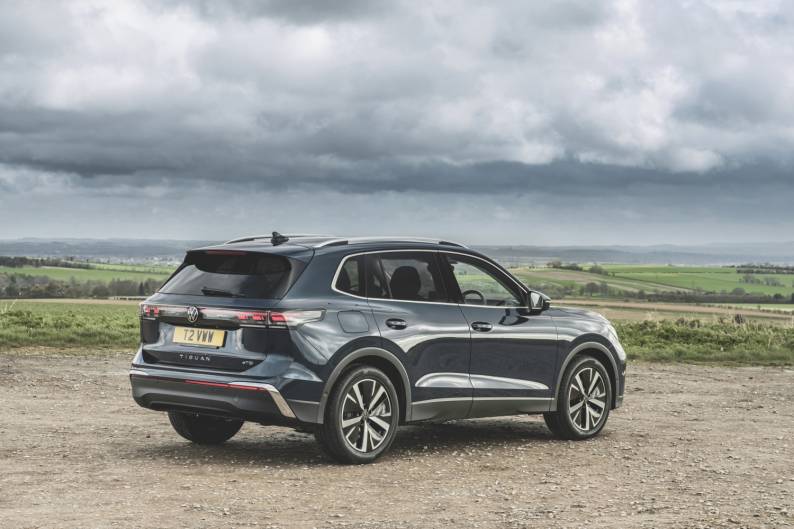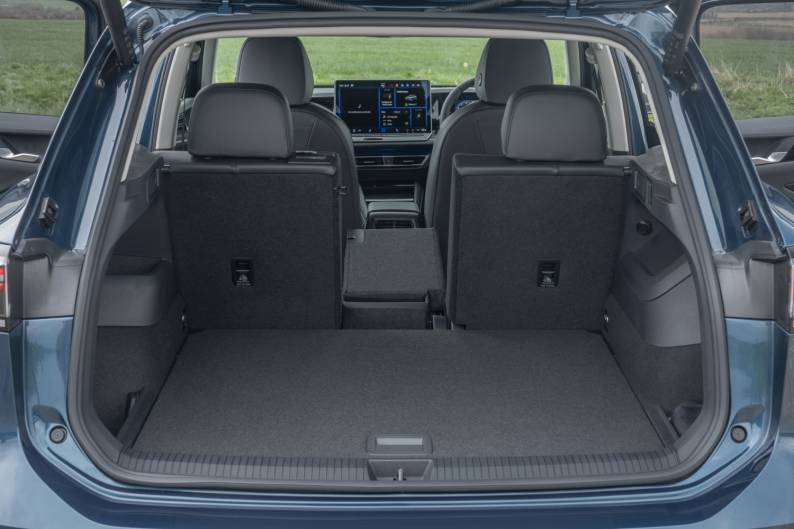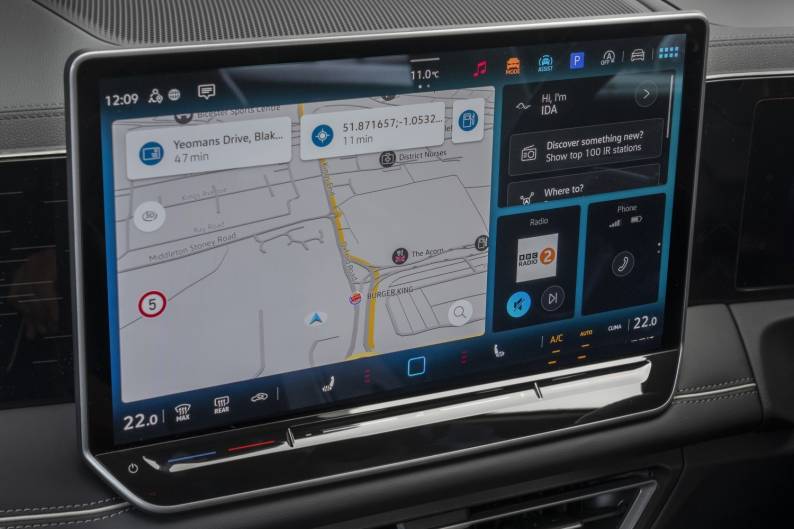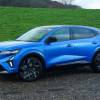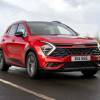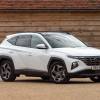
RAC sale – up to 33% off*
• Roadside cover from £5.29 a month†
• We get to most breakdowns in 60 mins or less
• Our patrols fix 4/5 breakdowns on the spot

Volkswagen’s popular Tiguan gets boosted with plug-in hybrid power. But is it the best choice for buyers? Lawrence Allan takes a closer look.
Things you'll like
- Impressive electric range and efficiency
- Refined and easy to drive
- Solid, spacious cabin
Things to consider
- PHEV’s price premium isn’t small
- Reduced boot space
- Unsettled ride in R-Line form
What is the Volkswagen Tiguan eHybrid?
In simple terms, a plug-in hybrid (PHEV) version of the latest, third-generation VW Tiguan that arrived early on in 2024.
Volkswagen has plenty of history with combining petrol and electric power, but the Tiguan’s is relatively short. The brand previewed a ‘Tiguan GTE’ concept way back in 2016 to sit alongside the already established Golf and Passat GTE PHEVs – but it all but disappeared as a casualty of VW Group cost-cutting after the ‘Dieselgate’ diesel emissions scandal.
It wasn’t until late 2020 when the previous-generation Tiguan finally received a plug-in version, instead with the eHybrid moniker (eTSI is reserved for the mild-hybrids). That first effort boasted a range of about 31 miles on a charge – decent by the standards of the day.
Electrification has progressed a great deal in a few years, though, so this new Tiguan eHybrid steps it up with an electric range of more than double the previous model, combined with greater efficiency, more performance and more tech.
‘More’ doesn’t automatically mean ‘better’, however, so is this new electrified Tiguan now the default choice in the range? We find out in this in-depth review.
You can also read our overall Volkswagen Tiguan review for more details about the rest of the range.
Verdict: is the Volkswagen Tiguan eHybrid a good car?
We reckon the Tiguan eHybrid is up there with the best plug-in hybrid family SUVs on sale. The impressive range on a charge means exceptional efficiency potential and low tax, while performance is strong and refinement is good. Most of the regular car’s family-friendly merits remain, but boot space takes a hit. It isn’t cheap, either, so it’s more appealing to company car users than private buyers.
Pricing, specs & rivals
The Tiguan eHybrid commands a chunky price premium over regular petrol and diesel models, as is often the case with plug-in hybrids.
You can’t get the eHybrid powertrain in base spec form, so you’ll need to upgrade to Life trim. At £42,665, the cheapest 204hp eHybrid is over £5,000 more expensive than the base 130hp petrol version – if only £750 or so more than the Skoda Kodiaq iV with the same hybrid system.
Upgrading to Match trim adds a mere £175, although Elegance takes the price up to £45,235. R-Line adds another £405 to Elegance, but the 272hp eHybrid variant is £48,360 – pricey, but cheaper in list price terms than the flagship 300hp Renault Rafale PHEV.
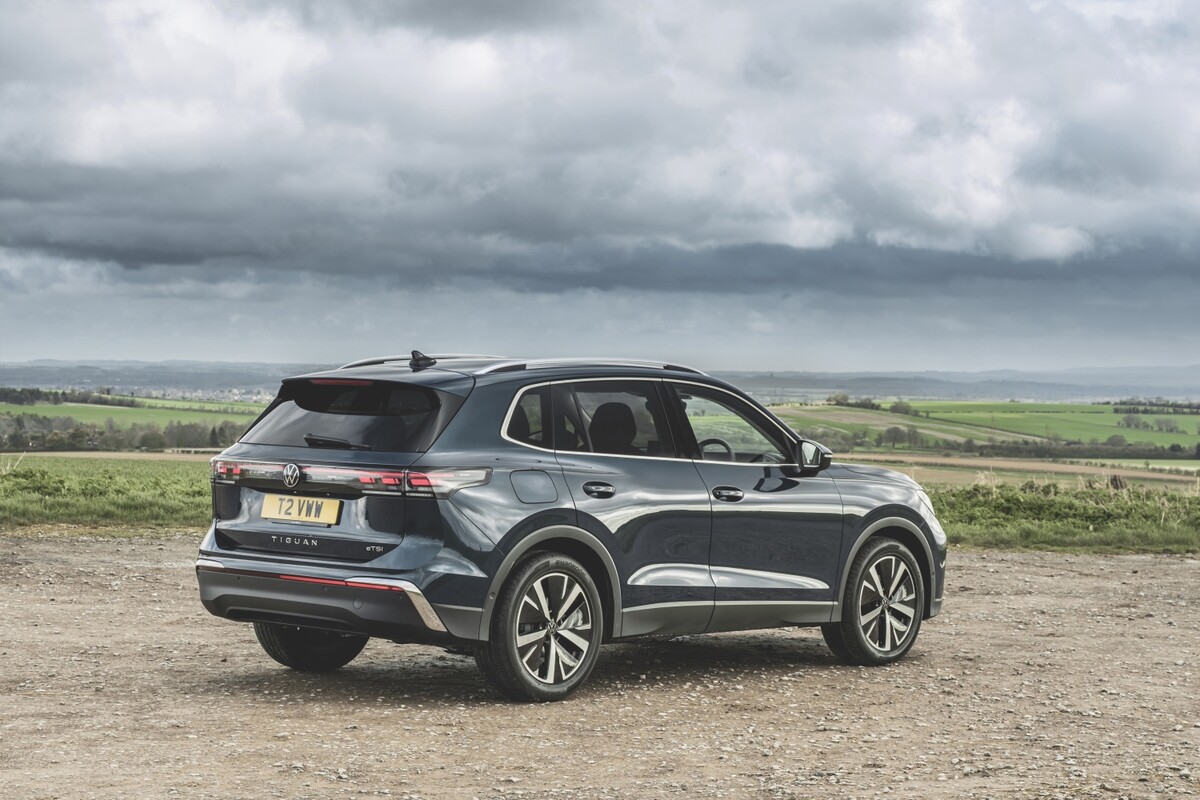
Kit levels are no different from standard Tiguans with the same trim levels. Life trim gets 18-inch alloys, adaptive cruise control, three-zone climate control, electric folding mirrors, wireless phone charging, ambient lighting, voice control and electric lumbar support.
Match trim looks better value overall, adding keyless entry, dynamic beam LED headlights with cornering lights, LED rear lights and a full-width DRL strip on the front, an electric tailgate and laminated glass for reduced wind noise.
Elegance upgrades the wheel size to 19 inches, adds further ambient lighting details in the cabin, a 360-degree camera system and heated and massaging front seats. R-Line trim focuses on styling upgrades with sporty detailing inside and out, sports seats and 20-inch alloys.
Rivals
The regular Tiguan has a huge variety of family SUV rivals, but the eHybrid narrows things down a bit because not all these alternatives can be had as a plug-in hybrid.
Peugeot is soon to launch a plug-in hybrid 3008 that compares closely with the Tiguan, while the Ford Kuga, Renault Rafale, Hyundai Tucson, Kia Sportage and Toyota RAV4 are all available in PHEV form.
The Skoda Kodiaq is fundamentally the same as the Tiguan underneath, but a bit roomier, while VW’s more upmarket image means you might also want to consider cars like the plug-in hybrid Volvo XC60, BMW X3, Mercedes-Benz GLC and Lexus NX.
Volkswagen Tiguan eHybrid: Interior comfort, quality & technology
There are no physical differences to the cabin of the Tiguan eHybrid versus the regular models, bar some alternative graphics on the digital dial display.
That means you get a smart overall design and good – if not outstanding – levels of fit and finish. You’ll find a decent amount of soft-touch materials, and the patterned ambient lighting found in higher-spec models adds a nice flourish to an otherwise strait-laced interior.
A Peugeot 3008 offers more visual appeal, while the Renault Rafale might beat the VW in the quality and ergonomics stakes, but the Tiguan still gives off a more premium air than most mainstream SUVs.
It’s comfortable, too, with supportive seats and a driving position offering plenty of adjustment. All versions feature electric lumbar adjustment, while niceties such as massaging seats and adjustable thigh support come in Elegance trim.
The Tiguan doesn’t try to look like a coupe on the outside, and the result is much better visibility than more low-slung rivals. The driver gets a good all-round view out, while standard all-round parking sensors and a rear-view camera mean parking is no hardship.
Our only complaints surround the new steering column stalks. The right stalk is now the gear selector (like VW’s electric cars) but that means all the light and wiper functions are crammed on a single left-hand stalk, which can be fiddly to operate until you’re used to it. Still, at least there are physical steering wheel buttons.
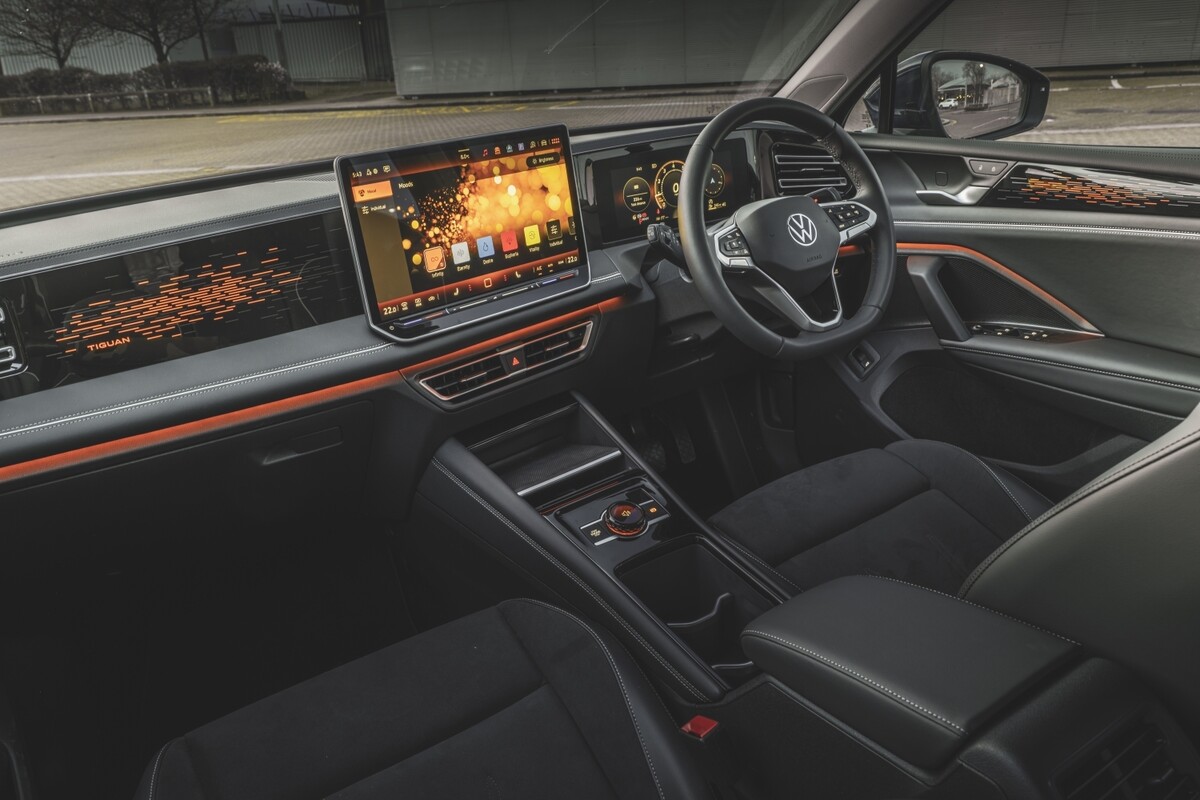
Infotainment, sat-nav, stereo and connectivity
All Tiguan eHybrids get the same 12.9-inch touchscreen infotainment system mounted high up within the driver’s line of sight. That is unless you go for the ‘Infotainment Package Plus’, which ups the screen size to a bulky 15 inches.
That extra screen size adds a little to usability on the move simply due to the bigger icons, while the head-up display the package also brings is a bonus. Both screens have the same overall software and graphics, though, so it’s not essential.
VW’s latest infotainment software is considerably improved over earlier versions of this setup, thanks to a more intuitive menu design and quicker screen responses. Customisable shortcuts help tailor the system to your needs, too.
However, we find ourselves banging the same old drum regarding the touch sensitive controls below the screen. They may now be backlit unlike earlier efforts, but a bank of physical dials for the climate controls is still far easier to use on the move.
New for this Tiguan is a rotary dial with an OLED display that can switch between volume adjustment, drive mode selection or ambient lighting functions. You also get wireless Android Auto and Apple Carplay, USB-C connectors front and rear and, on Life trim and above, wireless phone charging. The base eight-speaker audio system delivers decent sound quality, but there’s also a 10 speaker Harman Kardon upgrade if you fancy it.
How practical is the Volkswagen Tiguan eHybrid?
There’s no real difference in passenger space with the eHybrid than there is the in regular Tiguan, meaning it’s a practical space for four adults or a growing family.
Adults are very well catered for up front, with comfortable seats and a wide cabin for plenty of elbow room, while the rear compartment is among the roomiest of all plug-in hybrid rivals apart from the fractionally larger Skoda Kodiaq iV.
Legroom is plentiful (if not as limo-like as a VW Passat) while headroom generous even with the panoramic glass roof fitted. There’s also good space to slide your feet under the front seats, but the transmission tunnel means tighter legroom for three across the back than some alternatives.
The outer rear seats slide and recline to let you juggle boot space and rear legroom, too, while reclining backrests boost comfort further.
Storage and boot space
There’s plenty of storage in the Tiguan eHybrid including a big glovebox, generous door bins, a space under the centre armrest and a flexible centre console area. In the rear there are also chunky door bins, pockets in the front seatbacks and cupholders in the centre armrest.
Flexible 40/20/40 also remain in the PHEV version, while it’s easy to fold the seats using the boot-mounted levers. You might need to do that more often than in the regular version, however, as you lose a chunk of boot space by option for the eHybrid.
Whereas petrol or diesel Tiguans offer an impressive 652 litres of boot capacity, the eHybrid sees that fall to 490 litres. You can blame the sheer size of the battery for that, as rivals with smaller packs offer a bit more boot space.
The main fly in the ointment is the Skoda Kodiaq, which still offers a huge 745 litres of space even in plug-in hybrid form. Still, the Tiguan’s boot losses are mainly in underfloor storage, so it’s still a practical shape overall.
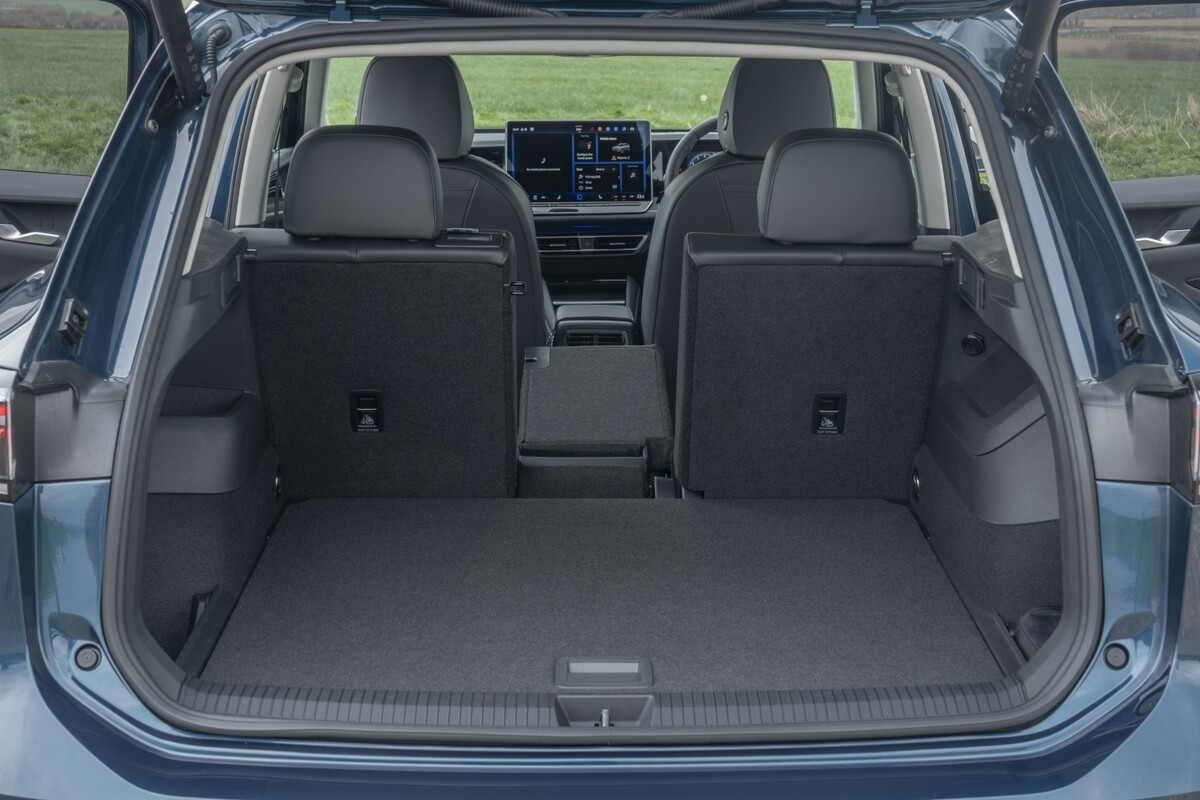
Performance & drive: What is the Volkswagen Tiguan eHybrid like on the road?
Out and out acceleration is not what these cars are about – gentle, efficiency-seeking driving is key to maximising the Tiguan eHybrid’s greatest assets. But both versions will get up to speed swiftly enough if required.
Both versions use the same 1.5-litre TSI turbo petrol engine as you’ll find in entry-level Tiguans, but power is fed through a six-speed dual-clutch gearbox (rather than the usual seven-speed) and combined with a 115hp electric motor. The only difference between the 204hp and 272hp version is software tuning.
The 272hp version is solely available in R-Line trim for a more sporting identity. It delivers a strong turn of speed when you floor the throttle and the car gives you a certain period in ‘boost’ mode (where the engine and electric motor output is maximised). If anything, it can be too strong at times, with the car struggling to maintain its line and the steering writhing in your hands.
There’s little ‘sporting’ about the way it goes about this: the petrol engine gets coarse when revved out and the gearbox isn’t the slickest by DSG standards. As such, we reckon the 204hp is a better bet: it’s cheaper, more efficient and isn’t exactly sluggish.
Both cars will always keep a little power in reserve even on an empty battery, but the Tiguan’s acceleration does feel stronger with some plug-in charge on board. It’s a shame the PHEV system can’t be mated to the seven-speed DSG, however, as at motorway speeds it can feel like it needs to drop another gear to reduce revs.
Regenerative braking features in the eHybrid, too, recouping some electricity when you brake or coast. There’s a ‘B’ mode on the new column-mounted gear selector for maximum regen, or an adaptive system that scans the road ahead and applies regen effect when it deems necessary – it works pretty well. If you’d prefer manual adjustment you can do so via the touchscreen, but it’s quite fiddly, while the brake pedal itself can be tricky to modulate until you’re used to it.
Power, 0-62mph times
- Tiguan eHybrid 204: 204hp/ 8.2 secs
- Tiguan eHybrid 272: 272hp/ 7.2 secs
Ride and handling
Opting for the plug-in hybrid Tiguan means around 270kg added to the standard car, which isn’t exactly a lightweight itself. Even with the DCC adaptive dampers fitted to our test car, VW hasn’t managed to hide this bulk.
It’s most notable with the ride on undulating country roads or around town, where the ride gets a bit clumsy, thumping into sharp potholes and failing to contain body movements as well as regular petrol or diesel Tiguans.
It’s far from uncomfortable, but there’s no doubt the 20-inch wheels on our test car contribute: smaller wheels should help it smooth out the UK’s poor surfaces better. That means you’re unlikely to use firmer Sport mode – Comfort mode provides a decent ride balance, but you can soften things off further with the slider control for the adaptive dampers.
The eHybrid is some way from feeling agile, but it’s at least competent, with accurate steering, good grip levels and decent body control making it feel less bulky than it actually is. It’s a long way from fun, though – another reason to avoid the faux sportiness given off with the R-Line 272 model.
Noise and refinement
The Tiguan’s driving refinement is a tale of two halves depending on your power source. In electric mode it’s delightfully smooth and quiet, with very little motor whine and an EV-like driving experience.
However, when the engine fires up the premium ambience is spoiled somewhat, because while it’s subdued in gentle driving it gets vocal when you ask for more performance. That, combined with the usual level of vibration a petrol engine adds, means you will notice the transition between electric and petrol power.
Road noise, too, is slightly louder than in the most refined plug-in SUVs – and that’s particularly the case with the larger wheel options of R-Line trim. Overall, though, this is a comfortable and relaxing SUV to travel in.
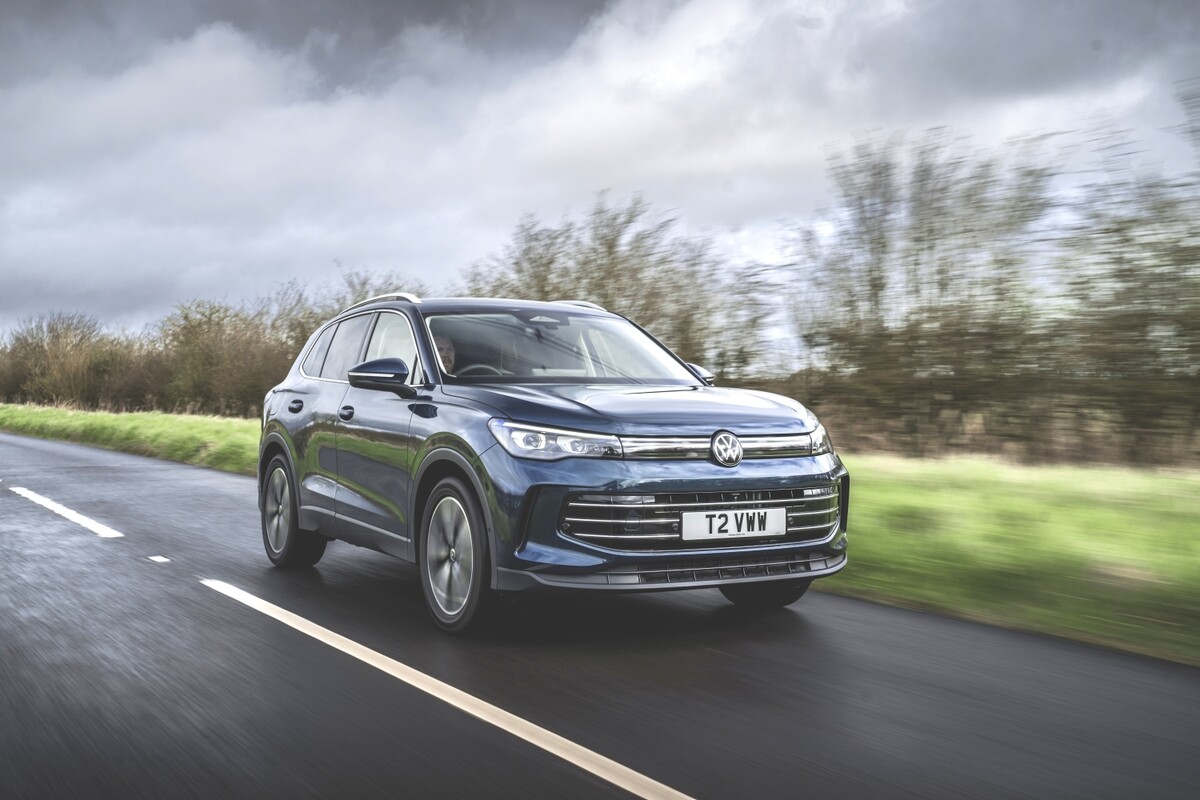
Euro NCAP: is the Volkswagen Tiguan a safe car?
The eHybrid version of the Volkswagen Tiguan offers the same level of safety protection as the regular petrol and diesel versions, meaning it receives the maximum five-star rating in crash tests by Euro NCAP.
That means all-round category scores that place the Tiguan among the safest options in its class. It also means plenty of assist technology including autonomous emergency braking, lane keeping assistance, traffic sign recognition and blind spot monitoring standard across the range.
Even base versions also comes with a driver fatigue monitor, an exit warning system, swerve support and oncoming vehicle braking when turning. Life trim and above also features adaptive cruise control.
Fuel economy and running costs
An impressive electric-only range (more on that below) translates to some mind-boggling official fuel economy figures for the Tiguan eHybrid.
Opting for the 204hp version nets you the best figure: an outstanding 706mpg combined. That drops to a still very strong 565mpg for the 272hp model. The usual plug-in hybrid caveat applies, however: to achieve those figures in WLTP tests the eHybrid will have run on battery power almost all the time, so if you spend more time with the petrol engine running you won’t see anything near that figure.
That’s not to say it’s unrealistic: if, say, you lived 50 miles from the office and could charge there as well as at home, then you’d likely achieve or maybe even beat those figures. Charging discipline is important, though, as on longer runs where the petrol engine is primarily powering the car the economy will drop considerably.
Plug-in hybrids are hugely popular with business users because they enjoy massive company car tax savings – and with CO2 emissions as low as 9g/km for the Tiguan eHybrid it sits in the ultra-low 6% tax band.
However, it makes less sense for private buyers, particularly as the higher list price means you’ll also be stuck paying £590 a year for five years in car tax due to the ‘Expensive Car Supplement’, or luxury car tax.
Volkswagen Tiguan eHybrid: electric range and charging
The electric range of the Tiguan eHybrid is vastly more than the previous version, showing how much progress plug-in hybrids have made in the last few years.
Opting for the entry-level 204hp version gives you an official range of up to 77 miles on a charge before the engine kicks in. This figure drops to 72 miles with the more powerful eHybrid 272.
That’s enabled by a substantial 25.7kWh battery (around 20kWh of usable capacity – a bigger battery than the base model Fiat 500 Electric. In range terms the eHybrid is well ahead of rivals such as the Ford Kuga and Kia Sportage PHEVs, which sit at around 42 miles on a charge.
Even more impressive is the Tiguan eHybrid’s ability to charge on DC rapid chargers – most plug-ins can only make use of slower AC charging. Doing so gives you up to 50kW charging speeds, enabling a 10-80% charge time of around 26 minutes.
If you’re charging at home, meanwhile, an 11kW wallbox will get you a full charge in around 2 and a half hours. This increases to nearer 4hrs using a more typical 7kW wallbox.
The Tiguan eHybrid also gets a warranty that guarantees the battery will stay above 70% capacity for five years or 100,000 miles.
How much does the Volkswagen Tiguan eHybrid cost to insure?
The Tiguan eHybrid is likely to be a bit more expensive to insure than the regular petrol or diesel models. Insurance groups start at 27 for the base 204hp version in Life trim, rising to group 31 for the 272hp R-Line flagship.
Volkswagen Tiguan eHybrid FAQs
What is the Tiguan eHybrid?
eHybrid is Volkswagen’s name for its plug-in hybrid car models. In the Tiguan eHybrid, a 1.5 litre TSI petrol engine is mated to a 115hp electric motor and 19.7kWh battery, offering an all-electric range of up to 77 miles before the engine kicks in.
Does the Tiguan hybrid charge while driving?
No, the Tiguan eHybrid needs to be plugged into the mains to properly charge up the battery. However, it will restore a small amount of energy into the battery via regenerative braking and coasting while you are driving along.
How much does it cost to charge the Tiguan eHybrid?
It depends on whether you charge at home or use public charging. It could cost as little as £1.60 to charge the Tiguan eHybrid at home on an off-peak EV charging energy tariff, and as much as £15 on expensive DC rapid chargers.


